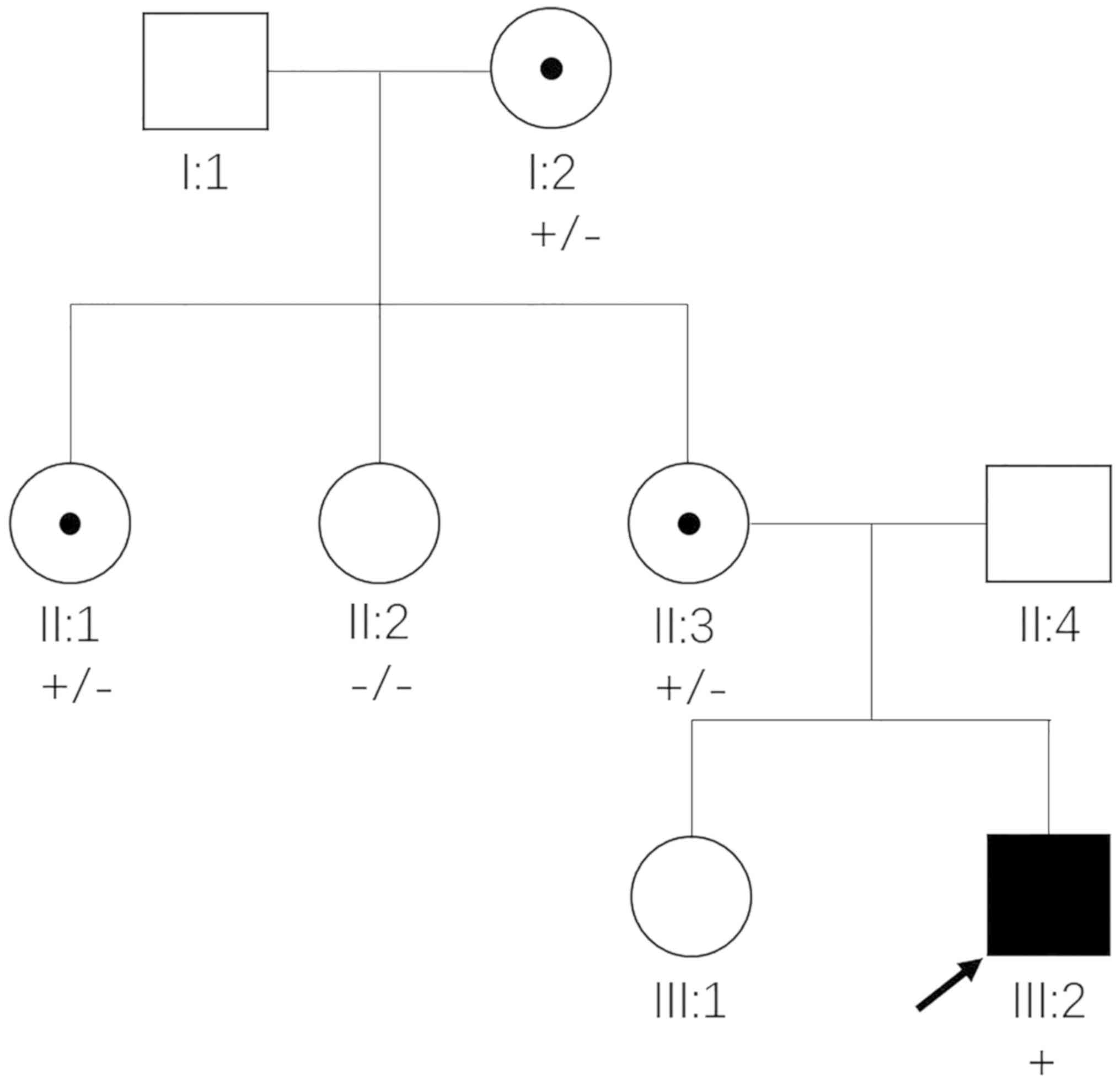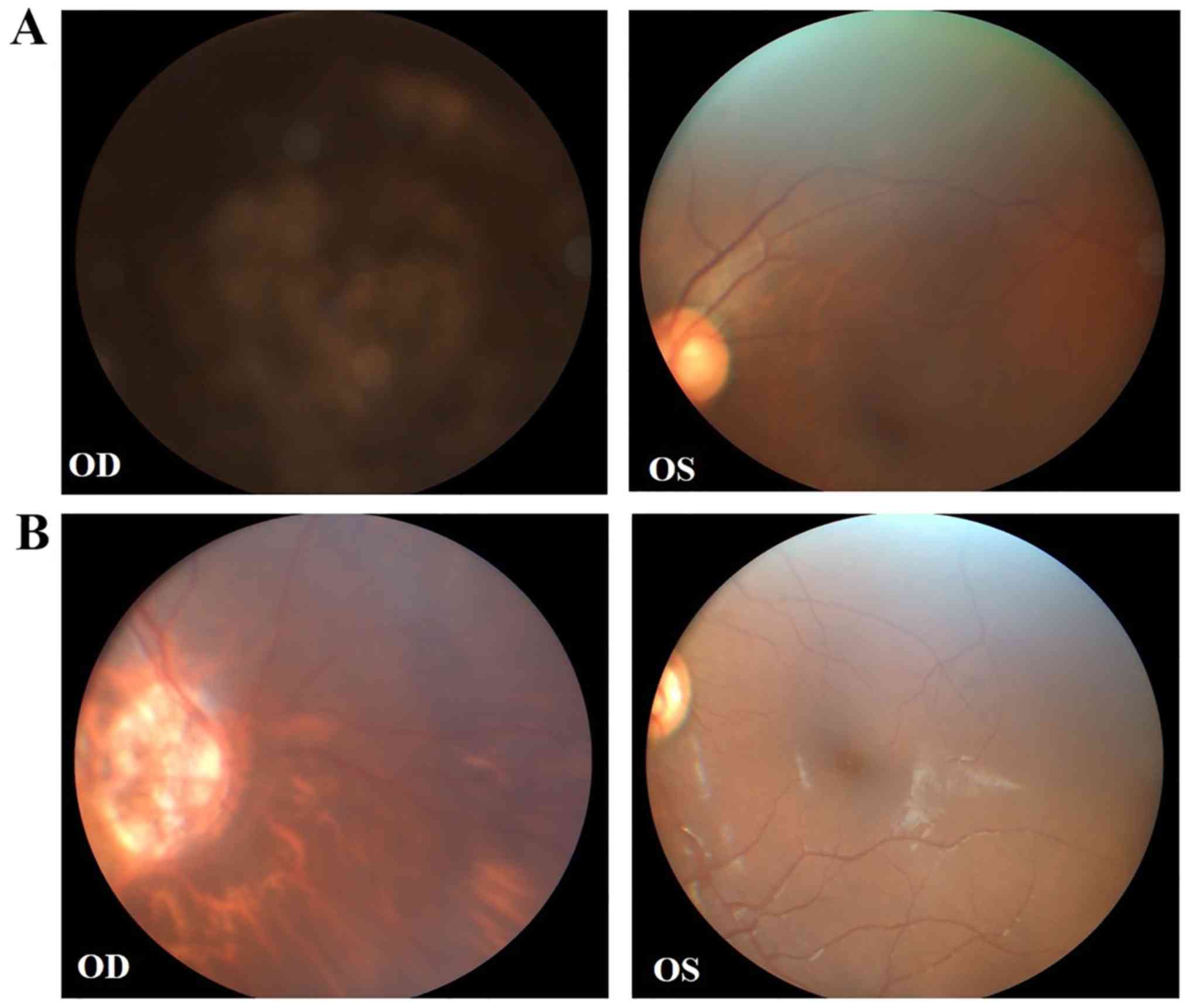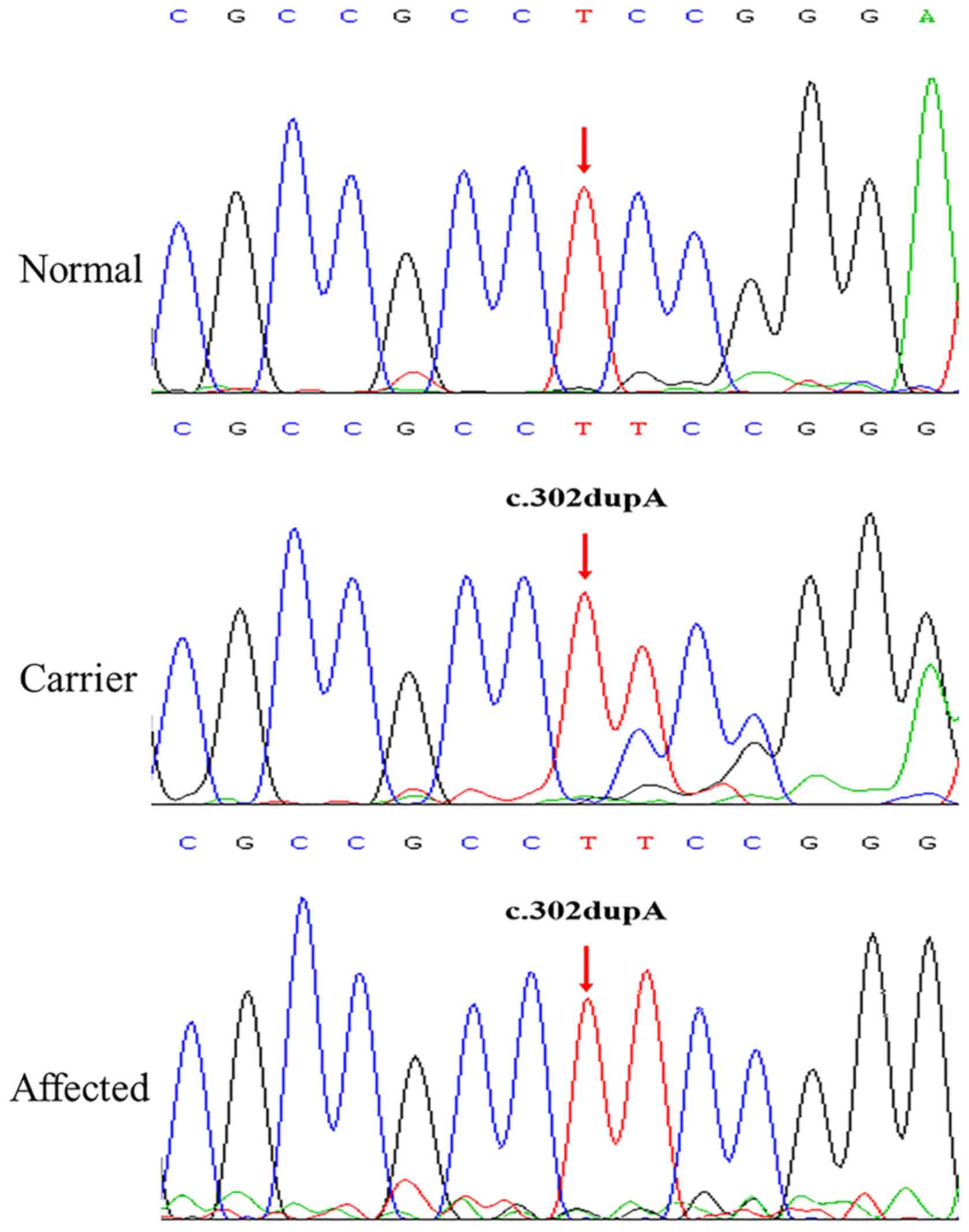A novel NHS mutation in a Chinese family with Nance‑Horan Syndrome
- Authors:
- Published online on: March 29, 2019 https://doi.org/10.3892/mmr.2019.10106
- Pages: 4419-4424
Abstract
Introduction
Nance-Horan syndrome (NHS; Online Mendelian Inheritance in Man no. 302350), also known as cataract-dental syndrome, is a rare X-linked inherited disease first described in 1974 (1–3). It is characterized by congenital cataracts, dental and craniofacial abnormalities, and mental retardation in ~30% of affected males (4–6). All affected males have bilateral severe congenital cataracts, usually requiring cataract surgery at an early age, and the majority also have congenital microcornea, nystagmus, strabismus or microphthalmia (7,8). Dental anomalies are a typical feature that may distinguish NHS from other types of congenital cataracts. Dental anomalies observed in patients with NHS include screwdriver-shaped incisors, supernumerary maxillary incisors (mesiodens) and a space between two teeth (diastema) (2). Dysmorphic facial features are usually mild and are often overlooked by ophthalmologists, but include a prominent nose and nasal bridge, a long narrow face, and large anteverted pinnae (2,9). Heterozygous carrier females often exhibit similar but milder, symptoms compared with affected males, including posterior Y-sutural lens opacities, little or no loss of vision, and occasional dental and facial abnormalities (10,11).
In the present study, a clinical and genetic analysis of a Chinese family with congenital cataracts and no obvious dental or craniofacial abnormalities was performed. A novel frameshift mutation in the NHS actin remodeling regulator (NHS) gene (c.302dupA; p.Ala102fs) was identified using whole exome sequencing (WES), and validated by direct sequencing. This result broadens the known phenotypic and genotypic spectrum of NHS-associated diseases.
Materials and methods
Subjects
A three-generation Chinese family was enrolled in the present study (Fig. 1). Ophthalmic examinations and disease diagnosis were performed in Liuzhou Maternal and Child Health Care Hospital (Liuzhou, China). The study adhered to the guidelines of the Declaration of Helsinki and the Association for Research in Vision and Ophthalmology statement on human subjects. All procedures were approved by the Ethics Committee of the National Research Institute for Family Planning (Beijing, China) and informed consent was obtained from the patients.
Whole exome sequencing and variant screening
The genomic DNA of 5 individuals of the family was extracted using the HiPure Blood DNA Mini kit (Qiagen GmbH, Hilden, Germany). WES of the proband (III:2) was performed using the SureSelect Human All Exon V5 kit (Agilent Technologies, Inc., Santa Clara, CA, USA) to capture all exons and enrich the DNA fragments. Sequencing was then performed using the HiSeq4000 sequencer (Illumina, Inc., San Diego, CA, USA), with Burrows-Wheeler Alignment software (bio-bwa.sourceforge.net/bwa.shtml; version bwa-0.7.12) to align the sequences against the human reference genome. Variants were labelled using the Genome Analysis Toolkit (www.broadinstitute.org/gatk/; version GATKv3.4.0), including single nucleotide variants and indels, and annotated using SnpEff (snpeff.sourceforge.net/SnpEff.html; version SnpEff_v4.1g).
Annotated variants were filtered by a series of processes: Firstly, exonic non-synonymous variants of cataracts-causing genes (12) were extracted, including missense, nonsense, frameshift and splice site mutations. Secondly, high frequency mutations with minor allele frequencies >1% in 1000Genomes (www.ncbi.nlm.nih.gov/variation/tools/1000genomes/), ESP6500 (evs.gs.washington.edu/EVS/) or ExAC (exac.broadinstitute.org/) databases were excluded. Then, genes with inheritance patterns that did not match the family were removed. Finally, genes responsible for syndromic phenotypes where cataracts are one of the features, but not the primary symptom, were excluded.
Candidate mutation validation and co-segregation analysis
The candidate mutation of the proband was validated by Sanger sequencing (performed by Beijing Liuhe Huada Gene Technology Co., Ltd., Beijing, China) with primers designed using Primer Premier 5 software (version 5.00; PREMIER Biosoft International, Palo Alto, CA, USA). Forward and reverse primers used to identify the NHS mutation were: 5′-GGACTGGCTGGACTGATTTGCT-3′ and 5′-CGCTCCCTTTCTGCTCCTTCT-3′, respectively. Sanger sequencing was then used to perform co-segregation analysis of mutation and disease phenotypes.
Results
Clinical manifestations
The proband (III:2), a 2-year-old boy, had diagnosed cataracts in both eyes following birth. Ophthalmic examinations revealed congenital cataracts with microcornea (horizontal corneal diameter =8 mm) and nystagmus. No other facial or dental abnormalities were observed, with the exception of slightly large anteverted pinnae. He underwent lentectomy without artificial lens implantation due to his young age. His mother (II:3) exhibited a congenital cataract with microcornea and strabismus of the right eye, and received cataract surgery. Fundus examination demonstrated unclear optic atrophy and tigroid fundus of the right eye, and the left eye was normal (Fig. 2A). The maternal aunt of the proband (II:1) also exhibited a congenital cataract of the right eye, and compound myopic astigmatism of the left eye with no obvious cataract. Fundus examination revealed similar results to those of II:3 (Fig. 2B). Detailed clinical features are summarized in Table I.
Table I.Clinical symptoms of carriers and affected members in the Chinese Nance-Horan Syndrome family. |
Identification of the pathogenic mutation
WES identified 79,533 single nucleotide polymorphisms and 9,307 indels in the proband. A total of 7 mutations in different genes were identified following the first two filtering processes, including 5 missense mutations, one splice acceptor mutation and one frameshift mutation (Table II). Variants of genes inherited in an autosomal recessive pattern were excluded, as the family tree suggested an autosomal dominant or X-linked inheritance pattern. A total of 3 genes, NHS, aldehyde dehydrogenase 18 family member A1 (ALDH18A1) and myosin heavy chain 9 (MYH9), were identified as candidates. However, ALDH18A1 and MYH9 are syndromic cataract genes. ALDH18A1 is one of the pathogenic genes of autosomal dominant or autosomal recessive inherited cutis laxa (13), which is primarily characterized by redundant, sagging, inelastic and wrinkled skin with variable systemic involvement (14). MYH9 is the pathogenic gene of Fechtner syndrome, which is characterized by hereditary nephritis, hearing loss, cataracts, macrothrombocytopenia and leucocyte inclusions, present in varying combinations (15). In cutis laxa and Fechtner syndrome, cataracts are one of the clinical manifestations, but are not the main phenotype. In addition, members of this family with cataracts did not present other clinical symptoms of cutis laxa and Fechtner syndrome. Therefore, ALDH18A1 and MYH9 were excluded. NHS is the pathogenic gene of NHS, which is characterized by congenital cataracts, and dental and craniofacial abnormalities, and mental retardation in ~30% of affected males (5,11). However, there are also certain NHS families with atypical clinical manifestations, that only exhibit congenital cataracts, and occasionally other concurrent ocular abnormalities (16). Tug et al (8) suggested that 100% of patients with NHS have bilateral congenital cataracts, 90% have large anteverted pinnae and only 65% have dental abnormalities. Therefore, NHS was identified as the only candidate gene.
The NHS frameshift mutation (c.302dupA; p.Ala102fs) identified in the Chinese family examined in the present study was absent in 1000Genomes, ESP6500 and ExAC databases, suggesting that it is a novel mutation. Sanger sequencing verified the presence of the NHS mutation in the proband (III:2). Subsequent co-segregation analysis among the 5 available individuals in this family detected c.302dupA in the 4 members with congenital cataracts (I:2, II:1, II:3 and III:2), but not in the unaffected member (II:2) (Fig. 3). The three female members (I:2, II:1 and II:3) were all heterozygous for this mutation, and exhibited similar but milder clinical symptoms to the affected male (III:2). These phenotypic discrepancies and segregation pattern conform to the disease features of NHS. Therefore, the NHS frameshift mutation, which altered the open reading frame and resulted in a premature truncated protein, was the pathogenic mutation of this family.
Discussion
In the Chinese family examined in the present study, the proband (III:2), his mother (II:3), maternal aunt (II:1) and maternal grandmother (I:2) exhibited congenital cataracts with other ocular abnormalities, but no marked craniofacial or dental anomalies. Therefore, all congenital cataracts-associated genes were initially screened. Subsequent to exclusion of high-frequency variants, genes with recessive inheritance patterns and those causing syndromic cataracts, a novel NHS frameshift mutation (c.302dupA; p.Ala102fs) was identified, which altered the open reading frame and resulted in a premature truncated protein. Sanger sequencing demonstrated that the mutation co-segregated with the primary phenotype; congenital cataracts.
NHS, located on Xp22.13, contains 10 exons and encodes at least 5 isoforms resulting from alternative splicing (16,17). NHS-A and NHS-1A are the two primary isoforms, encoding proteins of 1,630 and 1,651 amino acids, respectively, and are transcribed from exon 1. These 2 isoforms differ in that NHS-1A contains exon 3a and NHS-A does not (17). NHS-B is transcribed from exon 1b, is translated from exon 4, and encodes a protein 1,335 amino acids in length. NHS-C is transcribed and translated from exon 1a and encodes a protein containing 1,453 amino acids (6–8). Null mutations in NHS have been identified as causative of NHS (5,11). At present, ≥40 different NHS mutations have been described, originating in India, China, Australia, the United Kingdom, Turkey, Canada and the United States of America (http://cat-map.wustl.edu/). A number of these are nonsense mutations or indels, while a few are splice site mutations or copy number variations.
NHS is conserved in humans and other vertebrates, including mice (18). It is expressed in multiple tissues that regulate morphology and development, including the lens, craniofacial mesenchyme, dental primordia and brain (19). NHS isoforms exhibit spatial differences in expression. Isoforms containing exon 1 are expressed in the epithelia and are localized to the cell periphery, while isoforms lacking exon 1 are expressed in non-epithelial tissue and localized to the cytoplasm (7). Therefore, the pleiotropic features of NHS may be attributed to differences in subcellular localization and NHS protein isoforms. The N-termini of NHS-A and NHS-1A have a functional Wiskott-Aldrich syndrome protein-family verprolin-homologous protein homology domain, which serves an important role in the regulation of actin remodeling and the maintenance of cell morphology by interacting with Abl interactor proteins (17). NHS mutations in exon 1 were demonstrated to only disrupt the NHS-A and NHS-1A isoforms, while mutations in exons 3, 5 and 6 appear to affect ≥1 isoform type (20,21). The frameshift mutation identified in exon 1 (c.302dupA; p.Ala102fs) in the present study may cause the NHS disease phenotype by disrupting NHS-A and NHS-1A function.
In summary, the present study described the clinical manifestations of an affected male and carrier females in a Chinese family with NHS, and identified a novel frameshift mutation (c.302dupA; p.Ala102fs) in the NHS exon 1. The results of the present study broadens the known pathogenic mutation spectrum of NHS and will aid genetic counseling for patients with NHS. The identification of atypical NHS in the present study, with congenital cataracts and other ocular abnormalities but no marked craniofacial or dental anomalies, caused by an NHS mutation suggests that diagnosis may require a combination of clinical assessment and genetic analysis. There are certain limitations in the present study. Firstly, a frameshift insertion variant of NHS that was completely co-segregated with the disorder was identified. This provided only genetic evidence to the pathogenicity of the variant. Therefore, future experiments may be required to confirm these data. For example, whether the insertion affects the mRNA production, for example nonsense-mediated mRNA decay, may be verified by reverse transcription polymerase chain reaction. Concomitantly, the variant produced a truncated protein, which requires additional confirmation by performing western blot analysis. Finally, whether this frameshift variant is specific to this family or common in the Chinese NHS population was not determined. Future studies will require the analysis of more patients, to include a range of NHS variants.
Acknowledgements
Not applicable.
Funding
The present study was supported by the National Science and Technology Basic Work (grant no. 2014FY130100), National Infrastructure of Chinese Genetic Resources (grant no. YCZYPT [2017] 01), the National Key Research and Development Program of China (grant no. 2016YFC1000307-6), and Guangxi Science and Technology Project (grant no. ZY18164008).
Availability of data and materials
The datasets used and/or analyzed during the current study are available from the corresponding author on reasonable request.
Authors' contributions
MW, AQ, XM and BW were involved in the conception and design of the study. HM, and KW were responsible for the acquisition of data. MW, AQ, HM and KW were responsible for analysis and interpretation of the data. MW and AQ drafted the manuscript, and XM and BW critically revised the manuscript for important intellectual content. All authors read and approved the final version to be published.
Ethics approval and consent to participate
Approval of the present study was obtained from the Ethics Committee of the National Research Institute for Family Planning. All procedures adhered to the guidelines of the Declaration of Helsinki and the Association for Research in Vision and Ophthalmology statement on human subjects. Written informed consent was obtained from the patients.
Patient consent for publication
Written informed consent for publication of clinical details and clinical images was obtained from the patients.
Competing interests
The authors declare that they have no competing interests.
Glossary
Abbreviations
Abbreviations:
|
NHS |
Nance-Horan Syndrome |
|
WES |
whole exome sequencing |
References
|
Nance WE, Warburg M, Bixler D and Helveston EM: Congenital X-linked cataract, dental anomalies and brachymetacarpalia. Birth Defects Orig Artic Ser. 10:285–291. 1974.PubMed/NCBI | |
|
Walpole I, Hockey A and Nicoll A: The Nance-Horan syndrome. J Med Genet. 27:632–634. 1990. View Article : Google Scholar : PubMed/NCBI | |
|
Li H, Yang L, Sun Z, Yuan Z, Wu S and Sui R: A novel small deletion in the NHS gene associated with Nance-Horan syndrome. Sci Rep. 8:23982018. View Article : Google Scholar : PubMed/NCBI | |
|
Chograni M, Rejeb I, Jemaa LB, Châabouni M and Bouhamed HC: The first missense mutation of NHS gene in a Tunisian family with clinical features of NHS syndrome including cardiac anomaly. Eur J Hum Genet. 19:851–856. 2011. View Article : Google Scholar : PubMed/NCBI | |
|
Brooks SP, Ebenezer ND, Poopalasundaram S, Lehmann OJ, Moore AT and Hardcastle AJ: Identification of the gene for Nance-Horan syndrome (NHS). J Med Genet. 41:768–771. 2004. View Article : Google Scholar : PubMed/NCBI | |
|
Coccia M, Brooks SP, Webb TR, Christodoulou K, Wozniak IO, Murday V, Balicki M, Yee HA, Wangensteen T, Riise R, et al: X-linked cataract and Nance-Horan syndrome are allelic disorders. Hum Mol Genet. 18:2643–2655. 2009. View Article : Google Scholar : PubMed/NCBI | |
|
Li A, Li B, Wu L, Yang L, Chen N and Ma Z: Identification of a novel NHS mutation in a Chinese family with Nance-Horan syndrome. Curr Eye Res. 40:434–438. 2015. View Article : Google Scholar : PubMed/NCBI | |
|
Tug E, Dilek NF, Javadiyan S, Burdon KP and Percin FE: A Turkish family with Nance-Horan Syndrome due to a novel mutation. Gene. 525:141–145. 2013. View Article : Google Scholar : PubMed/NCBI | |
|
Lewis RA, Nussbaum RL and Stambolian D: Mapping X-linked ophthalmic diseases. IV. Provisional assignment of the locus for X-linked congenital cataracts and microcornea (the Nance-Horan syndrome) to Xp22.2-p22.3. Ophthalmology. 97:110–121. 1990. View Article : Google Scholar : PubMed/NCBI | |
|
Bixler D, Higgins M and Hartsfield J Jr: The Nance-Horan syndrome: A rare X-linked ocular-dental trait with expression in heterozygous females. Clin Genet. 26:30–35. 1984. View Article : Google Scholar : PubMed/NCBI | |
|
Burdon KP, McKay JD, Sale MM, Russell-Eggitt IM, Mackey DA, Wirth MG, Elder JE, Nicoll A, Clarke MP, FitzGerald LM, et al: Mutations in a novel gene, NHS, cause the pleiotropic effects of Nance-Horan syndrome, including severe congenital cataract, dental anomalies, and mental retardation. Am J Hum Genet. 73:1120–1130. 2003. View Article : Google Scholar : PubMed/NCBI | |
|
Messina-Baas O and Cuevas-Covarrubias S: Inherited congenital cataract: A guide to suspect the genetic etiology in the cataract genesis. Mol Syndromol. 8:58–78. 2017. View Article : Google Scholar : PubMed/NCBI | |
|
Nozaki F, Kusunoki T, Okamoto N, Yamamoto Y, Miya F, Tsunoda T, Kosaki K, Kumada T, Shibata M and Fujii T: ALDH18A1-related cutis laxa syndrome with cyclic vomiting. Brain Dev. 38:678–684. 2016. View Article : Google Scholar : PubMed/NCBI | |
|
Bhola PT, Hartley T, Bareke E; Care4Rare Canada Consortium, ; Boycott KM, Nikkel SM and Dyment DA: Autosomal dominant cutis laxa with progeroid features due to a novel, de novo mutation in ALDH18A1. J Hum Genet. 62:661–663. 2017. View Article : Google Scholar : PubMed/NCBI | |
|
Gershoni-Baruch R, Baruch Y, Viener A and Lichtig C: Fechtner syndrome: Clinical and genetic aspects. Am J Med Genet. 31:357–367. 1988. View Article : Google Scholar : PubMed/NCBI | |
|
Sun W, Xiao X, Li S, Guo X and Zhang Q: Exome sequencing of 18 Chinese families with congenital cataracts: A new sight of the NHS gene. PLoS One. 9:e1004552014. View Article : Google Scholar : PubMed/NCBI | |
|
Brooks SP, Coccia M, Tang HR, Kanuga N, Machesky LM, Bailly M, Cheetham ME and Hardcastle AJ: The Nance-Horan syndrome protein encodes a functional WAVE homology domain (WHD) and is important for co-ordinating actin remodelling and maintaining cell morphology. Hum Mol Genet. 19:2421–2432. 2010. View Article : Google Scholar : PubMed/NCBI | |
|
Ding X, Patel M, Herzlich AA, Sieving PC and Chan CC: Ophthalmic pathology of Nance-Horan syndrome: Case report and review of the literature. Ophthalmic Genet. 30:127–135. 2009. View Article : Google Scholar : PubMed/NCBI | |
|
Shoshany N, Avni I, Morad Y, Weiner C, Einan-Lifshitz A and Pras E: NHS gene mutations in ashkenazi jewish families with Nance-Horan Syndrome. Curr Eye Res. 42:1240–1244. 2017. View Article : Google Scholar : PubMed/NCBI | |
|
Ramprasad VL, Thool A, Murugan S, Nancarrow D, Vyas P, Rao SK, Vidhya A, Ravishankar K and Kumaramanickavel G: Truncating mutation in the NHS gene: Phenotypic heterogeneity of Nance-Horan syndrome in an Asian Indian family. Invest Ophthalmol Vis Sci. 46:17–23. 2005. View Article : Google Scholar : PubMed/NCBI | |
|
Sharma S, Ang SL, Shaw M, Mackey DA, Gécz J, McAvoy JW and Craig JE: Nance-Horan syndrome protein, NHS, associates with epithelial cell junctions. Hum Mol Genet. 15:1972–1983. 2006. View Article : Google Scholar : PubMed/NCBI |












